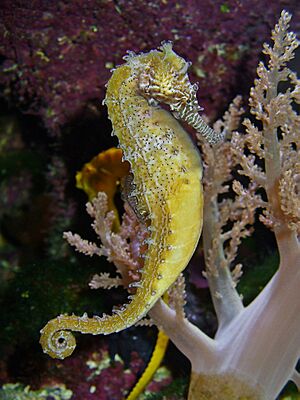Barbour's seahorse facts for kids
Quick facts for kids Barbour's seahorse |
|
|---|---|
 |
|
| Conservation status | |
| Scientific classification | |
| Synonyms | |
|
The Barbour's seahorse (Hippocampus barbouri) is a special type of fish. It belongs to the Syngnathidae family, which also includes pipefishes. These amazing creatures are known for their horse-like heads and upright swimming.
Contents
Where Barbour's Seahorses Live
Barbour's seahorses live in warm, shallow waters. You can find them near the coasts of the Philippines, Malaysia, and Indonesia. They often hide in seagrasses, which are like underwater meadows. They also live in mangrove swamps, estuaries, and muddy areas. These seahorses usually stay in water that is less than 10 metres (33 ft) deep.
Why Barbour's Seahorses Need Our Help
Sadly, the number of Barbour's seahorses has been dropping. Their population has gone down by about 30% in the last 10 years. This is mainly because of two big problems. People are catching too many of them. Also, their homes, like the seagrass beds, are being destroyed.
Because of this, the Barbour's seahorse is listed as "Vulnerable" by the IUCN Red List. This means they are at risk of becoming endangered. Experts first put them on this list in 1996. People who trade seahorses in places like Malaysia have noticed fewer of them available. Barbour's seahorses are often caught for traditional medicines and for aquariums.
What Barbour's Seahorses Eat
Barbour's seahorses are tiny hunters. They mostly eat small creatures that float in the water. Their diet includes small shrimp, tiny crustaceans, and little copepods. They also enjoy eating the young (larvae) of decapods and polychaetes. Sometimes, they even eat fish larvae.
How to Spot a Barbour's Seahorse
Barbour's seahorses have some cool features that help you identify them. They have sharp spines on their bodies. You can see them on their eyes, nose, and cheeks. The longest spine is usually on their back. Their tails are quite short compared to their bodies. The tail also has a mix of long and short spines.
These seahorses come in many colors. They can be white, yellow, greenish-gray, or light brown. Some even have reddish-brown spots or lines. Male Barbour's seahorses are usually a bit bigger than females. Males grow to about 11–15 centimetres (4.3–5.9 in) long. Females are a bit smaller, averaging 11–13 centimetres (4.3–5.1 in). People sometimes confuse them with the hedgehog seahorse, which looks similar.
How Barbour's Seahorses Have Babies
Barbour's seahorses have a unique way of having babies. The female seahorse lays her eggs into a special pouch on the male's belly. The male then carries the eggs until they are ready to hatch. This is called being ovoviviparous.
During the pregnancy, the male and female seahorse strengthen their bond. They greet each other every day. The eggs stay in the male's pouch for about 12 to 14 days. When the babies are born, there can be anywhere from 10 to 240 tiny seahorses! After birth, the parents don't take care of their young. Barbour's seahorses usually mate with the same partner for a whole season. They can have many broods of babies in one season.
How Barbour's Seahorses Stay Safe
Young Barbour's seahorses are the most at risk from predators. To stay safe, they use a trick called crypsis. This means they blend in with their surroundings. Their spiny skin and colors help them hide among the corals where they live. It makes them very hard for predators to see!
Who Named the Barbour's Seahorse?
The Barbour's seahorse is named after a famous American zoologist and herpetologist. His name was Thomas Barbour, and he lived from 1884 to 1946.


